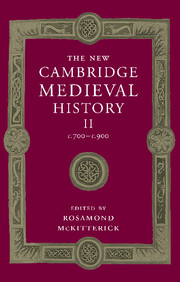Book contents
- Frontmatter
- PART I POLITICAL DEVELOPMENT
- PART II GOVERNMENT AND INSTITUTIONS
- PART III CHURCH AND SOCIETY
- PART IV CULTURE AND INTELLECTUAL DEVELOPMENTS
- 25 Eighth-century foundations
- 26 Language and Communication in Carolingian Europe
- 27 The Carolingian renaissance: education and literary culture
- 28 Theology and the organisation of thought
- 29 Book production in the Carolingian empire and the spread of Caroline minuscule
- 30 Art and architecture
- Conclusion
- Appendix genealogical tables
- List of primary sources
- Bibliography of secondary works arranged by chapter
- Index of manuscripts
- General index
- Frontispiece">
- Plate section
- Map 4 Charlemagne’s Europe and Byzantium, 814
- Map 19 The ecclesiastical provinces of western Europe 700-900
- Map 20 Carolingian schools, scriptoria and literary centres
- Genealogical table X: Wessex
- References
27 - The Carolingian renaissance: education and literary culture
from PART IV - CULTURE AND INTELLECTUAL DEVELOPMENTS
Published online by Cambridge University Press: 28 March 2008
- Frontmatter
- PART I POLITICAL DEVELOPMENT
- PART II GOVERNMENT AND INSTITUTIONS
- PART III CHURCH AND SOCIETY
- PART IV CULTURE AND INTELLECTUAL DEVELOPMENTS
- 25 Eighth-century foundations
- 26 Language and Communication in Carolingian Europe
- 27 The Carolingian renaissance: education and literary culture
- 28 Theology and the organisation of thought
- 29 Book production in the Carolingian empire and the spread of Caroline minuscule
- 30 Art and architecture
- Conclusion
- Appendix genealogical tables
- List of primary sources
- Bibliography of secondary works arranged by chapter
- Index of manuscripts
- General index
- Frontispiece">
- Plate section
- Map 4 Charlemagne’s Europe and Byzantium, 814
- Map 19 The ecclesiastical provinces of western Europe 700-900
- Map 20 Carolingian schools, scriptoria and literary centres
- Genealogical table X: Wessex
- References
Summary
the impetus for learning
writing towards the end of the ninth century, Notker Balbulus, teacher, scribe and librarian at the monastery of St Gall, recorded what he and doubtless many others thought about the origins of the Carolingian revival of learning. Two Irishmen, he claimed in his Gesta Karoli Magni, came to the Continent hawking wisdom and were eventually brought to the attention of Charlemagne who ‘was always an admirer and great collector of wisdom’. Soon after, Notker reported, the Anglo-Saxon Alcuin heard of the king’s love of wisdom and took to sea to meet him. Although the simplicity of Notker’s explanation of the wellspring of the Carolingian renaissance is attractive, it reduces a complex phenomenon to virtual parody. Irishmen, Anglo-Saxons, Visigoths and Italians were instrumental in defining the renaissance, but the programme had its roots in the eighth century with missionaries like Boniface and with political leaders such as Charlemagne’s father, Pippin III. What Charlemagne and his coterie of scholars, principally Alcuin but others as well, contributed to the revival of learning was a sense of mission, constancy, example, reinforcement and support.
Keywords
- Type
- Chapter
- Information
- The New Cambridge Medieval History , pp. 709 - 757Publisher: Cambridge University PressPrint publication year: 1995
References
- 22
- Cited by

